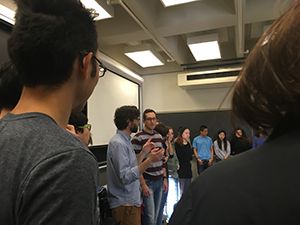In this section, Kyle Keane and Andrew Ringler discuss the centrality of teamwork in the workshop. They also share two strategies fostering a culture of collaboration.
The Importance of Teamwork
We believe collaborating with other people is an enjoyable part of life. It’s also critical. As technology becomes more complicated, it’s growing increasingly less feasible to do any significant project alone. An important aspect of the Arduino workshop is helping participants learn comfortable ways to form teams and to function productively within them. In fact, in naming the workshop, “Collaborative Design with Arduino Microcontrollers,” we intentionally put the word “collaborative” first in the title; participants use Arduinos to program microcontrollers, but engaging in teamwork is really the focus of the workshop experience.

Participants preparing for an improv exercise. (Image by H. Sharon Lin, MIT OpenCourseWare.)
Setting Expectations
So how do we cultivate a culture of collaboration? On the first day of the workshop, we talk explicitly about how the point of being together in this shared space is for participants to find things that excite them, for them to share this excitement with others, and to feel vulnerable. In other words, we’re here for social learning and social reinforcement. We tell students, “This workshop is voluntary. You can choose to be here or not, and you can leave at any point. So, if you stay here, stay here for a purpose. Stay here to interact with other people.” Having this conversations helps us establish the expectation that collaboration will be a norm in the workshop.
Modeling Vulnerability
Modeling social vulnerability also helps us foster a collaborative learning environment. And this can feel really embarrassing! After all, modeling vulnerability in front of a classroom of undergraduates and graduate students is not something we typically do when we’re deriving at a blackboard. But we should!
So we make a point to do it in the workshop. Recently, participants were giving presentations in the workshop. I (Kyle) stood up in the front of the classroom and role-played with the participants. At the beginning of my mock-presentation, I said, “I’m sharing my work with you. What is your response going to be? I need you to ask questions that are supportive, that show that you’re interested.”
I also spoke about the emotions and their physical counterparts, like sweaty palms, that I was experiencing. I encouraged them to share their work with others despite feeling vulnerable: “You’re going to feel nervous. You only had two weeks to work on your projects and you didn’t come to this workshop with professional skills; this is not a refined presentation. Don’t be embarrassed. Just feel those feelings and share your work.”
Modeling vulnerability is not a very common post-secondary teaching strategy, but I think it’s an important thing to do when building team dynamics, because, let’s face it, opening yourself up to critique is terrifying. And there’s no point at which it stops being terrifying. So, as instructors, we try to face our own fears about doing it. We stand in the front of the classroom and talk about how it feels to be vulnerable. We’re weirdly explicit about it, but we find it extremely effective.
Drawing on Improvisational Comedy
"I use improv warm up exercises (games performers play to get ready for a show) to help participants explore how verbal and nonverbal communication impact their collaborative relationships in the workshop."
I (Andrew) tend to draw heavily on my experience with improvisational comedy, or improv, to lay the foundation for the social interactions that make teamwork possible and enjoyable. One thing that’s really interesting about improv is that there’s no script, so the only focus is you and the other person on stage. Together, you have an impromptu conversation, responding to each other, without having any idea what your partner will bring next to the conversation. It’s about working in relationship with one another. I use improv warm up exercises (games performers play to get ready for a show) to help participants explore how verbal and nonverbal communication impact their collaborative relationships in the workshop.
One of the improv exercises I do is called Red Ball. Participants pass an imaginary red ball, and, over time, the game gets complicated, because we introduce more imaginary balls that have similar sounding names, like “yellow ball,” “bouncy ball,” and maybe “bread bowl” or “Red Bull.” There’s an action associated with every ball name, such that when participants toss a “Red Bull,” they have to act out opening a can of soda. We quickly introduce balls as others are being passed around, and it creates chaos.
At the end of the exercise, I ask, “Who has the red ball? Who has the yellow ball? Who has the Red Bull?” Sometimes two or more people think they have particular balls. Or a ball goes missing! This leads to conversations about the importance of agreement in communication. Participants have to think about who they passed a ball to, and if that person agreed to receive it. In other words, did that person even know someone was passing them a particular ball? We also talk about what happens when there’s no one to receive a ball, because everyone’s looking in different directions. In other words, the exercise allows us to have conversations about the communication issues participants will encounter in their collaborative design process. It’s also a fun way to get participants comfortable making mistakes—which reinforces the idea that being vulnerable in this setting is not only okay, but the norm.










